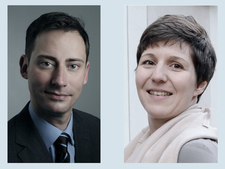-
Topics
subnavigation
Topics
Electromagnetic fields
- What are electromagnetic fields?
- Static and low-frequency fields
- Radiation protection relating to the expansion of the national grid
- High-frequency fields
- Radiation protection in mobile communication
Optical radiation
Ionising radiation
- What is ionising radiation?
- Radioactivity in the environment
- Applications in medicine
- Applications in daily life and in technology
- Effects
- What are the effects of radiation?
- Effects of selected radioactive materials
- Consequences of a radiation accident
- Cancer and leukaemia
- Genetic radiation effects
- Individual radiosensitivity
- Epidemiology of radiation-induced diseases
- Ionising radiation: positive effects?
- Risk estimation and assessment
- Radiation protection
- Nuclear accident management
- Service offers
-
The BfS
subnavigation
The BfS
- About us
- Science and research
- Laws and regulations
- BfS Topics in the Bundestag
- Links
Best paper of the year award for uranium miners study
Year of issue 2015
Date 2015.03.18
Date 2015.03.18
Researchers from the Federal Office for Radiation Protection (Bundesamt für Strahlenschutz, BfS) received the best paper award from the German preventive medicine journal "Arbeits-, Sozial- und Umweltmedizin (ASU) – Zeitschrift für medizinische Prävention" for their scientific work on the health effects of uranium mining. The award recognises, among others, the "importance to the scientific community"
and the "traceability of results"
.
The authors of the winning paper managed to make the study about the miners of the former GDR uranium mining company "Wismut" accessible to a wider audience of experts in Germany. "The study and its results are of great importance to radiation protection and occupational safety and health"
said Michaela Kreuzer from the BfS. Kreuzer leads the study and is one of the authors of the prize-winning paper. Today it is vital to target occupational and environmental physicians, to whom the results are highly relevant, said the epidemiologist. The scientists’ review article summarises the results of 20 years’ research work. The prize-giving ceremony was on March 18 in Munich.
Importance of the "Wismut Study"
The so-called "Wismut-Study", which is being performed under the auspices of the BfS, is the largest study on radiation and dust exposure in uranium mining worldwide. The study follows up a cohort of roughly 60 thousand miners over a period from 1946 until today. The large amount of validated data helps provide a better understanding of the health consequences of exposure to radiation and dust, and their combined effects. Exposures include inhalation of the radioactive noble gas radon and fine quartz dust.
The scientific findings gained from this study are crucial for occupational radiation protection. They are important to occupational physicians as a scientific basis of procedures for recognition of occupational diseases. Thanks to this study, radiation and dust-induced diseases in uranium miners can be addressed based on the evidence provided, thus giving a more differentiated picture today than in the past. Furthermore, the results are vital for a better protection of the general public, since elevated radon concentrations may also occur in homes and public buildings in certain areas.
Study results
According to the study, roughly 3,500 workers died from lung cancer and almost 1,000 from silicosis, a respiratory disease, up to 2008. The mortality from lung cancer is twice that of the general public. This increase is mainly due to radon and its daughter products, but also to fine quartz dust. The effects of smoking and radon are mutually reinforcing, i.e. the two risks tend to multiply, whereas the combined effects of radon and fine quartz dust tend to add up.
For the first time, the scientists also focussed on rarely occurring diseases based on the findings of the large-scale study. There is evidence suggesting a possible relationship between exposure to radon and cancer in the ear, nose and throat region. The number of these diseases has not been statistically significant up to now in studies with a smaller data volume. Furthermore, the longer the period of record, the more light will be shed on correlations of radiation and dust exposure at dose levels clearly lower than in mining.
Information on the "Best Paper Award"
The "Best Paper Award" is given to the authors of the best scientific contribution published in the German preventive medicine journal "ASU – Zeitschrift für medizinische Prävention" once a year. The jury is composed of three occupational physicians. Their choice is based on the importance to experts, the quality of the study design, the traceability of results, and the study size.
State of 2015.03.18



